|
April 27, 2017
April 28, Day of Mourning for Workers
Killed or Injured on the Job
Workers Strive to Provide the Right to
Safe and Healthy Working Conditions
with a Guarantee
PDF
April
28,
Day
of
Mourning
for
Workers
Killed
or
Injured
on
the
Job
• Workers Strive to Provide the Right to Safe
and Healthy Working Conditions
with a Guarantee
• Defend the Right of Workers to Safe and
Healthy Working
Conditions! - Normand Chouinard
• Stand With Fort McMurray Firefighters! -
Peggy
Morton
• Workers Speak Out in Defence of Their Rights
• Brutal Statistics on Fatalities and
Injuries at Work
• Canada Pays Its Respects -- Workers'
Monuments and Memorials
April 28, Day of Mourning for
Workers Killed or Injured on the Job
Workers Strive to Provide the Right to
Safe and Healthy Working Conditions
with a Guarantee
April 28, 2017 is the 33rd annual Day of
Mourning for Workers Killed or Injured on the Job, a day when workers
across Canada and around the world participate in ceremonies and
meetings and observe a moment of silence to mourn the dead and fight
for the living.
 Once again this year, the
occasion is marked by workers' striving to provide the right to safe
and healthy working conditions with a guarantee. Besides their
day-to-day fights with individual employers, they blame governments,
and rightly so, for refusing to provide this right with a guarantee. It
is governments which must hold all those who employ labour to account.
Continuously today, employers and especially the big corporations get
away with murder thanks to the refusal of governments to enforce
regulations on health and safety or hold companies to account that
bypass regulations in all manner of insidious ways. Instead,
governments themselves are removing regulations which uphold health and
safety. They claim such regulations are not good for business, which
reveals what interests governments serve, and it is not those of the
people. Far from holding the corporations to account, governments
themselves wage an ideological offensive which criminalizes workers who
stand up for their rights and against the degradation of their working
conditions. Once again this year, the
occasion is marked by workers' striving to provide the right to safe
and healthy working conditions with a guarantee. Besides their
day-to-day fights with individual employers, they blame governments,
and rightly so, for refusing to provide this right with a guarantee. It
is governments which must hold all those who employ labour to account.
Continuously today, employers and especially the big corporations get
away with murder thanks to the refusal of governments to enforce
regulations on health and safety or hold companies to account that
bypass regulations in all manner of insidious ways. Instead,
governments themselves are removing regulations which uphold health and
safety. They claim such regulations are not good for business, which
reveals what interests governments serve, and it is not those of the
people. Far from holding the corporations to account, governments
themselves wage an ideological offensive which criminalizes workers who
stand up for their rights and against the degradation of their working
conditions.
Powerful private interests claim that looking after the
health and safety of workers is a cost of production that must be
reduced if they are to succeed in their international competition with
their rivals for profit and dominance in world markets. They demand
that the issue of workplace health and safety be left in their hands as
a private and
even secret affair because revealing the health and safety conditions
would make them vulnerable to their competitors! Governments are
serving this dictate with a variety of measures, such as
establishing "industry self-regulation" in the railways and other
significant sectors of the
economy. The Ontario government too has now amended the Occupational
Health
and
Safety
Act to introduce self-regulatory systems.
At the same time, the monopolies declare that they are
totally committed to workers' health and safety. They proclaim that
their facilities are the safest and that the workers produce there
without injuring themselves. They put up signs everywhere that read
"This workplace is accident-free." The real conditions and facts are
something else.
Across the board, workplace safety is made a matter of
workers' attitudes. Workers are blamed for accidents and disciplined
when they are injured or when they object to unsafe working conditions.
The Workers' Compensation Boards do the same, blaming accidents on
workers' bad behaviour. They systematically challenge workers' claims
on fraudulent grounds, such as claiming that a worker's injury was the
result of a pre-existing condition, not their working conditions.
Every day workers face a wall of silence that they
strive to smash to ensure that their needs and rights are respected and
that all workers, without exception, are protected. Safe and healthy
working conditions and appropriate compensation for workplace injuries
is part of workers' exchange with their employer of their capacity to
work in return for definite conditions that are acceptable to them.
These conditions are now denied, creating an unviable situation in
relations of production in the workplace and society.
Every passing day brings workers face-to-face with the
need to turn the situation around in their favour as regards their
health and safety and that of the public by intensifying their
resistance and demanding a new direction for the economy which
recognizes and guarantees the rights of all. To this end, workers are
finding the ways
and means to
speak out and smash the silence on their working conditions. The
slogan, Our Security Lies in the Fight for the Rights of All
guides them to build unity in action and make sure they are not
criminalized for upholding their right to refuse unsafe work.
On April 28, Mourn the Dead and Fight for the
Living! This issue of Workers' Forum is dedicated to all
those who are doing so today.

Defend the Right of Workers to Safe and Healthy Working
Conditions!
- Normand Chouinard -
In the days leading up to April 28, the Day of Mourning
for Workers Killed or Injured on the Job, workers are thinking about
how to pay tribute to their peers who have been injured or killed at
work or have died or are ill as a result of their working conditions.
Activities are being held across the country involving thousands of
workers who will carry the same message, "One death is too many." The
problem of how to participate in production without losing one's life
or seriously injuring oneself is a daily concern for the working class
as a whole.
On this important issue, too, there is a battle between
the outlook of oligarchs who want to "take charge" of the "health and
safety" issues of "their" employees and the outlook of workers
everywhere who seek solutions to ensure their full safety at work. The
workers know that the corporations, those who control them and their
political representatives, block any organizing work of the working
class to take control of its security. The systematic and conscious
obstruction by corporations with the objective of destroying what the
workers themselves want to build is one of the urgent problems to be
solved. The message of the oligarchs is clear: "Leave your health and
safety to us. Trust us. Don't listen to your organizations that just
want to take your money. We will pay for you and everything will be
fine." This message only aims to paralyze and make the working class,
its organized and unorganized sections, passive. It also aims to sow
doubt in our ability to transform our workplaces to make them safer.
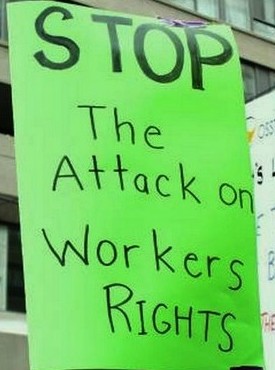 The oligarchs' method is
very clear: to intensify the exploitation of the working class by
increasing hours of work and productivity while extorting concessions
from the workers using the police powers of the state. This
offensive inevitably leads to more dangers and accidents. To divert the
workers' attention, "health and safety programs" take the form of an
advertising campaign about the importance for the company that "their"
workers adopt good behaviour. "Reward programs" for those who have no
accidents further make workplace safety a matter of behaviour and
attitude. This is not to mention the privatization of health and safety
prevention, in which private firms are tasked with publicizing the
latest products that will allegedly ensure our safety. In short,
workers are told to leave their fate to the corporations under the
pretext that there is no force more concerned to ensure workers' safety
at work. The oligarchs' method is
very clear: to intensify the exploitation of the working class by
increasing hours of work and productivity while extorting concessions
from the workers using the police powers of the state. This
offensive inevitably leads to more dangers and accidents. To divert the
workers' attention, "health and safety programs" take the form of an
advertising campaign about the importance for the company that "their"
workers adopt good behaviour. "Reward programs" for those who have no
accidents further make workplace safety a matter of behaviour and
attitude. This is not to mention the privatization of health and safety
prevention, in which private firms are tasked with publicizing the
latest products that will allegedly ensure our safety. In short,
workers are told to leave their fate to the corporations under the
pretext that there is no force more concerned to ensure workers' safety
at work.
On April 28, this is what workers must reject. While
paying tribute to their peers, workers must hold the
political authorities and private corporations accountable. They must
stop their obstruction and attempts to destroy what the workers want to
build. It is a fundamental right of the working class not to leave
their fate to the
rich to protect them.
The workers must persist in their efforts to create the
organizations needed to transform workplaces and make them safe at all
levels. It is up to the workers to discuss, develop and decide on the
agenda on all matters relating to their safety at work and to
consciously participate in transforming the situation in their favour.
The state and public and private workplaces should facilitate the
affirmation of this right. Putting the full weight of workers'
organizations behind this issue can make a difference. Without doing
so, the working people are at the mercy of the rich.
Our Security Lies in the Fight for
the Rights of All!
One Death Is One Too Many!

Stand With Fort McMurray Firefighters!
- Peggy Morton -
Results of a study have confirmed that many
firefighters
who fought in the rescue operations in Fort McMurray in May 2016 are
suffering from ongoing health problems. Close to 3,500 firefighters
were involved in battling the fire. They came from across Alberta and
Canada and from as far away as the state of Jalisco in Mexico. Close to
90,000 people were forced to leave as the devastating forest fires
raged. The people of Fort McMurray and emergency workers accomplished
the evacuation of their city under extremely perilous conditions.
Post-traumatic stress has become another problem the
people have to cope with because they were left to fend for themselves
during the fire and since then are left to themselves to find solutions
to the problems they face as a result of the fire. Meanwhile, the
companies who hire the workers that have been brought to
Fort McMurray to live while they work for them are let off scot free.
While they build firewalls around their camps and work sites, they are
not held responsible for building the same around Fort McMurray. This
is unacceptable, because the damage caused by such a devastating fire
could be avoided if the human factor is taken into account by
governments in Canada.

The release of the study on the consequences of fighting
the fire on the health of the firefighters coincides with the
anniversary of that event. Dr. Nicola Cherry, an epidemiologist at the
University of Alberta School of Public Health, and her team met the
first wave of exhausted firefighters from Strathcona County as they
returned from Fort McMurray last May to measure the toll the heavy
smoke and ash had taken on their respiratory systems. Dr. Cherry
reports that a "very large proportion" of the 355 firefighters surveyed
were suffering from respiratory symptoms such as shortness of breath,
coughing, wheezing and chest tightness.
The researchers later met with the
firefighters
again and found that one in five were still having respiratory problems
caused or made worse by the fire. As well, one in six was suffering
from mental-health issues. Dr. Cherry stated that the firefighters may
develop more serious issues over time.
Dr. Cherry emphasized the importance of learning from
the fire so
that measures can be taken to provide more protection to firefighters
in the future. She is calling on all firefighters involved in fighting
the Fort McMurray fire to contact her to participate in the next phase
of the study. Changes to protect workers' health could involve
modifying the length of shifts, and the type of respiratory protection
used.
Urban firefighters are exposed to a large and complex
mixture of
toxins from fires that can include combustion by-products of organic
and synthetic material, solvents, heavy metals, pesticides, and
industrial chemicals. Known carcinogens include asbestos, benzene,
formaldehyde, soot, benzopyrene and dioxins.
Many forest firefighters continued to battle the blaze
for many
weeks. Wildland fire emissions include carbon dioxide, fine particulate
matter, carbon monoxide, volatile organic compounds such as
formaldehyde and acrolein, nitrogen, and sulfur oxides, as well as
lower levels of carcinogens like polycyclic aromatic hydrocarbons,
according to a
study published in the BC Medical Journal.
Firefighters, their unions and the organized workers'
movement
fought a long battle for recognition of the long-term health
consequences of their work and presumptive workers' compensation
coverage. They experience higher rates of at least four types of
cancer. A large study by the U.S. National Institute for Occupational
Health and Safety
provided definitive proof that firefighters face a greatly increased
risk of cancer as a result of their work. But forest firefighters are
still excluded from presumptive legislation which recognizes an
increased cancer risk, and no presumptive coverage for respiratory
illnesses exists in Canada. This shows the clear need to step up the
collective efforts
to defend workers' health and safety and their right to a livelihood
when they experience illness or injury from their work.
The people of Fort McMurray, especially the
firefighters, first responders, water treatment plant workers, health
care workers, and all the workers who carried out their
responsibilities with courage and dedication reveal what is most
precious about Canada's working class and people. The duty of
governments to make sure they are looked after when injured on the job
must be enforced.

Workers Speak Out in Defence of Their Rights
On the occasion of the April 28 Day of Mourning, Workers' Forum is publishing
interviews with representatives of workers in steel, construction, the
railways and the public service and representatives from injured
workers and migrant workers which discuss the problems in their sectors
and how they are working to uphold their right to health and safety.
They show the all-sided attacks taking place against the rights of
workers and the challenges workers are taking up to turn things around.
Doug Finnson, President, Teamsters Canada Rail
Conference
A major problem is the complete unfairness in the
present
structure. Federal legislation allows the railroads to have their
secret Safety Management Systems (SMS), self-regulating in secrecy, and
the workers do not have equality when it comes to health and safety in
the railroad industry in Canada. They do not have an equal seat at the
table.
The structure is dominated by the railroads, supported by the
legislation. The workers in the railroads have minimal rights. We can't
even find out what the SMS details are that govern us. We are facing a
kind of private club of the railroads and the bureaucrats buried inside
the Department of Transportation.
 It is the bureaucrats
buried inside these offices that
are
making the rules with the railroads. The Ministers come and go and it
is naive of us to think that the present system of secret SMS is the
creation of the Ministers themselves. Governance is in the hands of the
bureaucrats and the railroads, not in the hands of the elected
officials. The
bureaucrats are buried inside these offices and the lobbyists for the
railways are marching up and down Parliament Hill and they are just
loving it. They are the ones making up the rules and the Minister comes
along and says "well everything looks good, that is fine," but what
does he know? With the secrecy of the SMS, the railways can justify
almost everything. With this structure, in the daily life of the
workers and taking the workers on an individual basis, the railways
effectively block the concerns that workers have. This structure is
limiting the participation of the workers. It is the bureaucrats
buried inside these offices that
are
making the rules with the railroads. The Ministers come and go and it
is naive of us to think that the present system of secret SMS is the
creation of the Ministers themselves. Governance is in the hands of the
bureaucrats and the railroads, not in the hands of the elected
officials. The
bureaucrats are buried inside these offices and the lobbyists for the
railways are marching up and down Parliament Hill and they are just
loving it. They are the ones making up the rules and the Minister comes
along and says "well everything looks good, that is fine," but what
does he know? With the secrecy of the SMS, the railways can justify
almost everything. With this structure, in the daily life of the
workers and taking the workers on an individual basis, the railways
effectively block the concerns that workers have. This structure is
limiting the participation of the workers.
As far as we are concerned, we are going to continue
our fight on
fatigue management. We are not going to give up on any of the struggles
and we are going to continue our fight to break this wall of secrecy.
We also say that office workers should stay in their
offices and
let professional railroaders run the trains. To have unqualified people
running trains has already caused close calls and accidents.
April 28 reminds us that we cannot change the past
but we certainly
can affect the future. While we are mourning those workers who have
been killed or injured, it is up to the rest of us to keep fighting to
get safe workplaces.
Frank Mesich, Health and Safety Co-Chair,
United Steelworkers Local 1005, Stelco Hamilton Works
A major problem is cancer in the workplace. Cancers are
not being
related enough to the workplace. There are many deaths whose cause was
in the workplace but the company is saying that no, this is not the
case. This is hard to prove, but when you are working 40 hours a
week
for years and you get continually exposed to coke oven
emissions and benzene and light oil and other known carcinogens the
probability is that you brought that from the workplace. At home I am
not exposed to all these things and yet the company wants to tell you
that it is your life style that caused it. Every day we have people
coming into the union hall with different types of cancers. Right now
we
are trying to build an occupational clinic where you get everybody to
come who has occupational diseases and we go through their work history
and that sort of thing. This is an initiative of the local. We are in
the process of establishing such a clinic. There are so many other
issues, including mental health, and we have to keep fighting on all
these issues.
As you know, U.S. Steel used to have a behaviour-based
program.
We are starting to get away from that. What is happening now is that we
have kind of separate silos at Stelco, health and safety and human
resources each have their own agenda. When we have an incident and
something happens the Health and Safety Committee will
investigate. At the same times sometimes Human Resources will come to
investigate it, to see if somebody broke a procedure or a policy. We
have been getting away from that to some extent but under U.S. Steel it
was happening all the time, every time there was an incident. Now it is
not happening as much but when there is an incident that has
life-threatening potential HR usually gets involved. They seem to pick
and choose when they want to do that. Sometimes HR is giving out
punishment before the Health and Safety Committee has even investigated
it to see what happened. There was an incident recently where there was
a lockout issue with an electrician. Before the Health and Safety
Committee even conducted an investigation HR had already investigated
and handed out a punishment. But when we investigated the health and
safety issue we found out that there was a lot more to it than just
that the guys did not do what they were supposed to do. They were not
trained properly. There was some confusion as to whose responsibility
it was to do what. By continuing to ask "Why, why?" you go to the root
cause, but by that time they had already suspended the people for two
days each.
What they try to do is to scare the workers but do you
think that
by punishing the person the incident will not happen again? It is
always done to blame the workers but in these situations there are many
issues; there is the management issue, the training issue. Even when we
keep bringing up the facts from the health and safety investigation
the management of HR keeps challenging them.
My message on this April 28 is the basic message
we keep bringing
forward, which is to prevent workplace deaths, injuries and illnesses.
We keep fighting for that.
Serge Bourgon, Head of Occupational Health and Safety
Committee, Syndicat des cols bleus regroupés de Montréal
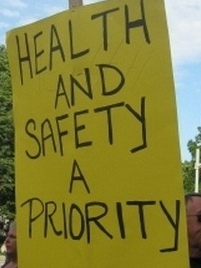 One of the main problems is
the lack of training and
information
provided to workers by the employer. To be able to understand a
procedure, you often need training. Information is about having a
working procedure, a protocol, and when the worker is not made aware of
it that causes a lot of problems. It seems the employers think that to
work with and inform the workers deprives the employers of a certain
power. They do not like the worker to be in a position to be critical
if a work procedure has not been respected by a superior. This causes
incidents and accidents. One of the main problems is
the lack of training and
information
provided to workers by the employer. To be able to understand a
procedure, you often need training. Information is about having a
working procedure, a protocol, and when the worker is not made aware of
it that causes a lot of problems. It seems the employers think that to
work with and inform the workers deprives the employers of a certain
power. They do not like the worker to be in a position to be critical
if a work procedure has not been respected by a superior. This causes
incidents and accidents.
Take the case of a worker who operated a natural ice
cleaning and polishing machine at Lac des Castors. The ice collapsed
and the machine tilted and fell. The worker got away but she suffered
post-traumatic shock which is still affecting her. Following this, it
has taken us about a year and a half to establish a safe work procedure
that takes into account all factors, including the thickness of the
ice, the weight of the machine, etc. Yet we had another case this year
where the ice collapsed under the machine and in our on-site
investigation we realized that almost half of the workers doing this
work had not been trained according to the procedure that took us so
long to establish. The union discloses dangers, calls for safe work
protocols; in other words, it insists on prevention. The employer is
reluctant to invest in procedures in the field for prevention.
There is also an issue with the contracts that are
awarded by
the city to others instead of having work done in-house by the blue
collars. With regard to contracts that are being awarded to the private
sector, generally the private companies are equipped to do the work and
have the necessary accreditations. But when they themselves
subcontract the work, there is no adequate monitoring of the workplace
and it has been necessary to intervene in cases where the work was done
in a totally unsafe manner by untrained people.
In non-profit organizations, to which the city is
increasingly
awarding contracts, health and safety conditions are even worse. People
are hired as "cheap labour" and are being given more and more work in
blue collar jobs and there is a serious decline in health and safety.
We have seen cases of scaffolds badly situated in the soil and operated
in a totally unsafe manner with unskilled personnel.
We are doing our best to intervene in those cases, even
though we do not have jurisdiction because they are not our workers.
Simon Lévesque, Head of Health and Safety
Department,
FTQ-Construction
The goal of employers should be to review health and
safety
measures because they are ineffective. The health and safety record is
not improving. It can be seen that, as far as the employers are
concerned, the involvement of workers in health and safety is not
important. According to articles 204 to 215 of the Occupational Health
and Safety Act, prescribing joint health and safety committees
and
prevention representatives, they should have been in place for years
and yet we do not have them. These articles, which would lead to the
direct involvement of workers, have never been promulgated.
At
Hydro-Québec we met with workers before the fatal accident of La
Romaine,
but we are no longer listened to. We have been working in these trades
for 25-30 years but supposedly "we know nothing." Workers who
raise
issues and complain about situations are gotten rid of and replaced by
people who do not complain. It is easy to get rid of them, to lay them
off, because there is no job security in construction.
Correcting the situation entails costs and it costs less to get rid of
the worker. When a death happens there are always a number of accidents
and warnings that precede it.
At the FTQ-Construction we kept making efforts, we keep
asking to have prevention representatives and we managed to get some.
We have won them on some construction sites. We got them at the Centre
Hospitalier de l'Université de Montréal, the Turcot
Exchange, the Romaine work site and the Champlain Bridge. We had one at
McKinnis Cement, but the site is built now. That is all, out of 25,000
construction sites in Quebec. For us to have prevention representatives
is something crucial. If workers do not know what a prevention
representative does, if they do not see them in action, it does not
give them confidence to demand to have them. For us it is important to
demonstrate that our prevention representatives are a plus for the
workers through the example of their work. Construction is at the top
of the first priority group in terms of health and safety according to
the Act. We need a prevention representative who is a construction
worker, chosen by the workers, trained by them and paid by the
employer. We do have some health and safety committees but the ones we
have are bogus and led by the employers and are just used by them to
show that they are doing due diligence.
Denis St-Jean, National Health and Safety Officer,
Public Service Alliance of Canada
There are many problems in regard to the health and
safety of
workers. The most important one, as far as PSAC is concerned, is
probably the issue of mental health and psychosocial risks in the
workplace within the federal public service and with other employers
because we also have members in all jurisdictions across Canada. We are
talking here about workplace stress and anxiety that contribute
significantly to mental health problems among our members. Even in
terms of long-term disability, it is estimated that about 50 per
cent of
all
claims over the last five years have been around mental health issues.
These are only the claims that have been recognized because it is not
always easy to go on long-term disability. These problems are linked to
the transformation of work, the pace of work, the workload, as well as
to instability in employment contracts, which increase psychological
distress. For workers, precarious employment is an extremely important
factor, part-time, casual, seasonal work, accompanied by anxiety
to be able to get one's job back in order to survive. One of our
concerns is to reduce the impact that the toxic workplace can create on
people who have mental health problems that are not always related to
work, such as bereavement, separations, divorces, those events of life.
In the toxic workplace this creates additional difficulties. There are
all
sorts of organizations that do a good job of promoting mental health,
but building a workplace that is part of the solution to manage
workers' mental health problems is one of the most important
challenges.
The PSAC has worked with various organizations to
develop a
national standard for psychological health and safety, a framework that
allows for a better approach to implementing preventive measures. We
participated directly in the drafting of this standard and incorporated
a clause into the collective agreement to have a joint working group
with employers to develop measures to implement mental health
prevention programs.
In its work, the PSAC makes sure that mental health
promotion and
prevention are not done top-down, are not top management initiatives
that find little response amongst workers who do not feel listened to.
We work to ensure the participation of workers through regular surveys
on this issue and by mobilizing them on health and safety
committees and other bodies. We raise the issues of workload and human
resource management, the need to develop resources that are
representative of the interests of workers.
In conclusion, I want to say that mental health affects
everyone.
It is not always the workplace that is the problem, but the workplace
can be part of the solution.
Peter Page, Coordinator, Justice for Injured Workers
Newspaper
The first thought that comes to mind is the tragedies
that happen
each year, the hundreds of workers who are killed or poisoned by their
workplaces. These tragedies are still going on so we are asking why the
WSIB (Workplace Safety and Insurance Board) continues to put the
employer first and the injured worker second. They are not
considering compensation for the injured workers as a right and a
social good but as a cost to society that has to be reduced.
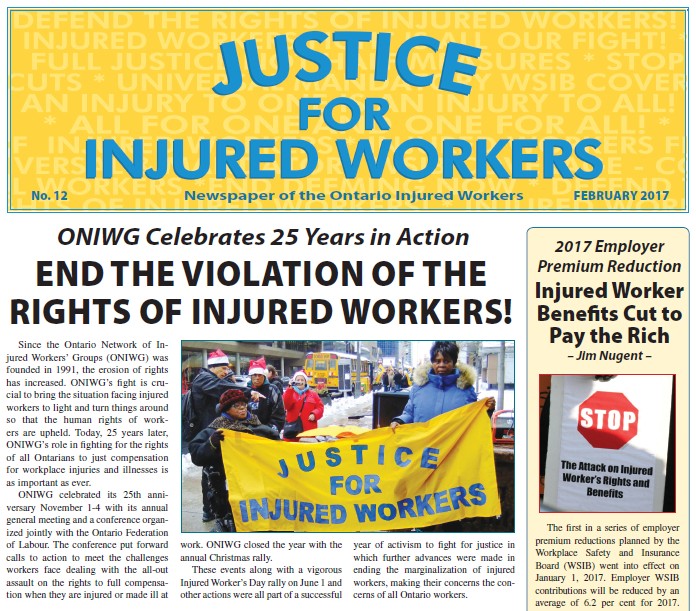 They are concerned about the unfunded liability,
about
making
Ontario open for business, which includes making our compensation
system more competitive with other jurisdictions. Workers' compensation
systems are being attacked across North America. With this idea of
Ontario open for business if, for example, the state of Ohio has
lower compensation rates, that would be an incentive for employers to
move to Ohio so as not to pay compensation and face fewer regulations
or for further attacks on our compensation system, and that is only
going to increase the way Trump is eliminating regulations. They are concerned about the unfunded liability,
about
making
Ontario open for business, which includes making our compensation
system more competitive with other jurisdictions. Workers' compensation
systems are being attacked across North America. With this idea of
Ontario open for business if, for example, the state of Ohio has
lower compensation rates, that would be an incentive for employers to
move to Ohio so as not to pay compensation and face fewer regulations
or for further attacks on our compensation system, and that is only
going to increase the way Trump is eliminating regulations.
The way the compensation system treats injured workers
continues to
be a problem. The WSIB is not following what they were mandated to do a
hundred years ago. The compensation system is not doing its duty. When
a worker is injured they are not providing them with the benefits they
are entitled to. They are pushing injured workers into
poverty. This is ongoing and is actually getting worse. Policy changes
at the Board are to reduce benefits of the injured workers. We want
them to stop deeming ["deeming"
refers to the practice used by the WSIB
to decide the compensation that it will pay for loss of earnings as a
result of workplace injury or illness. It reduces a permanently
injured worker's loss of earning benefits under the pretence that the
worker is employed. -- WF Note] Under deeming, when minimum
wages go up it is a
saving for the WSIB because they are deeming that an injured worker is
earning more money at the phantom job that they do not have and
benefits are reduced accordingly.
As we move forward we are concerned about the fact that
the Ontario
government is moving to some kind of self-regulation for employers,
where
employers would be like the fox in the henhouse, setting the rules for
the workplace. They are reducing the role of the Ministry of Labour
inspectors to go in and monitor workplaces. Letting
employers self-regulate is going to be a serious problem for injured
workers and for safety in the workplaces [as an example, Bill 70
was
passed by the Ontario government which amends the Occupational Health
and Safety Act to give the Chief Prevention Officer the power to
accredit health and safety management systems and to give
recognition to employers who use them. Employers are then able to
benefit from things such as reduced inspections by the Ministry of
Labour. This was done under the hoax of "lessening the burden on
employers by taking away unnecessary proactive inspections " -- WF
note]. We are also concerned about the Comprehensive Economic
and Trade Agreement with the European Union (CETA) and other global
trade agreements whereby if a company moves to Ontario and open shop
they do not necessarily have to follow our health and safety laws.
We are also pursuing legal actions like the one in
Supreme Court in
which the Ontario Network for Injured Workers' Groups (ONIWG)
intervened in a case out of Quebec to uphold the human right of the
injured workers to an accommodation with suitable duties when the
worker exercises their right to return to work. In the Ontario election
in 2018 ONIWG is planning to play an active role so that the
voices of
the injured workers are heard.
Then there is our Justice Bike Ride that starts
May 24 in Ottawa
and ends up June 1 at the rally at Queen's Park. This year's theme
is
RIGHTS FOR ALL (details here).
If you are denied your right to compensation you are
not getting
the benefits you need and are pushed into poverty; therefore you are
being denied your right to affordable housing and your other rights as
a human being. We are saying that denial of the rights of one means the
rights of all are being denied.
Sharmeen Khan, Migrant Workers Alliance for Change
The major issue is the systemic inequality within the
law, both the
provincial law and the federal law, in regard to migrant workers. The
contract that migrant workers have with their employer is the basis of
their ability to stay in the country. It is what we call a closed
permit, tied to the employer. If a worker works under unsafe working
conditions and gets hurt, it means that the moment they lose their job
because they were injured they can no longer stay in the country. They
face deportation. That only happens to low-wage migrant workers. Other
Canadian workers obviously don't face deportation. With that condition
of the closed permit it is very difficult for migrant workers to
defend themselves or receive benefits should they get hurt on the job
and have to leave. A secondary issue, especially with the Employment
Standards Act (ESA) in Ontario, is that there is not enough
enforcement from the government in workplaces where there are migrant
workers. The system is complaint-based and there is very little
incentive
to complain about the employer if your permit is tied to that employer.
When it comes to migrant workers we are kind of juggling with the
federal laws around the status of migrant workers and the provincial
laws around standards and safety and these laws are often in conflict
with one another and they are not coherent.
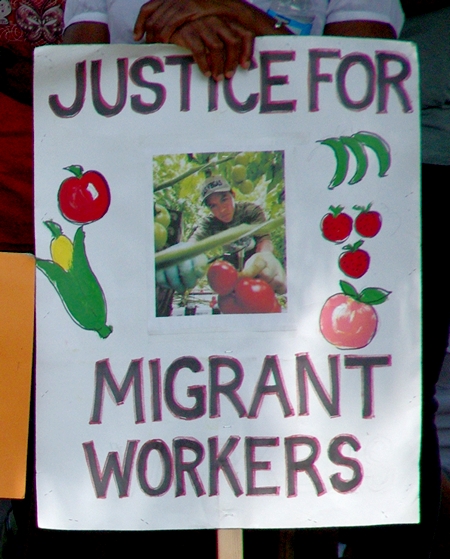 In our work, we put pressure
on governments with
campaigns. We
do organizing, hold demonstrations, lobby, etc. We have a petition on
our website that is asking for immediate steps by the federal
government to eliminate the requirement for an employer-specific work
permit and to grant migrant workers open permits. This is a first step
to
granting migrant workers permanent immigration status on landing. There
is a Standing Committee which is reviewing migrant workers that has
recommended the same thing but the government has not made any move to
change that. We were hoping it would happen during the budget but is
has not happened yet. We also train migrant workers so
that they know the laws and what their rights are so that they can
organize themselves, obviously with our support and solidarity. In our work, we put pressure
on governments with
campaigns. We
do organizing, hold demonstrations, lobby, etc. We have a petition on
our website that is asking for immediate steps by the federal
government to eliminate the requirement for an employer-specific work
permit and to grant migrant workers open permits. This is a first step
to
granting migrant workers permanent immigration status on landing. There
is a Standing Committee which is reviewing migrant workers that has
recommended the same thing but the government has not made any move to
change that. We were hoping it would happen during the budget but is
has not happened yet. We also train migrant workers so
that they know the laws and what their rights are so that they can
organize themselves, obviously with our support and solidarity.
Other workers need to stand in solidarity with migrant
workers because they are amongst the most exploited section of the
working class in Canada. We are saying that Canada has basically a
labour apartheid where migrant workers have different conditions from
other workers. No matter what your status is, a worker is a worker.
These workers do the agriculture work that other workers do not want to
do, they provide a lot of the food that we are eating, and with the
care giving workers they are contributing to make our country run. Some
of them work in very dangerous conditions with very little pay and some
of them have been working here with renewed contracts for years and
years and they can't get status. These workers should have a pathway to
status.

Brutal Statistics on Fatalities and Injuries at
Work
The most recent statistics available on fatalities and
injures at
work are from the Association of Workers' Compensation Boards of Canada
(AWCBC) from 2015. The statistics are brutal but it is claimed
that
they are lower than the previous year indicating an improvement. Those
who deal with health and safety at the workplace and
with injured workers across the country tell Workers' Forum
that these numbers do not tell the real story. They only include cases
that are accepted and covered by the compensation systems across the
country. Not only are a growing proportion of workers not covered by
these systems (especially those considered self-employed) but
others are refused compensation by private interests which have taken
over the compensation systems. The compensation system itself has
become "a very litigious, difficult, cumbersome system,"
representatives of injured workers say, adding that it is also not
funded properly. Workers report that their claims, when they are
legally allowed to make
a claim, are systematically being challenged.
The AWCBC says the number of lost time claims that are
being
accepted has been steadily decreasing since 1995
(from 410,464 in 1995
to 232,629 in 2015) while the number of fatalities has
remained 915 a
year on average. This likely indicates a high number of unreported
injuries even amongst
unionized workers, of challenged and rejected claims, and the massive
shift of the workforce towards precarious employment of all kinds.
The statistics show that in 2015, the number of
fatalities at work
was 852, down from 919 in 2014. This means 2.3
deaths every day. Among
the 852 dead, there were four young workers aged 15
to 19, 11 aged 20
to 24 and 28 aged 25 to 29 years.
Of these fatalities, 307 were due to traumatic
injuries and
disorders and 533 were due to diseases, the greatest number
being 361
cases of malignant neoplasms and tumours including cancers.
On top of these fatalities there were 232,629
claims accepted for
lost time due to a work-related injury or disease, down
from 239,643
in 2014. These included 8,155 from young workers aged 15
to 19, 22,052
from workers aged 20 to 24 and 23,839 from workers
aged 25
to 29. The AWCBC defines a time-loss injury as "an injury for
which a
worker is compensated for a loss of wages following a work-related
accident (or exposure to a noxious chemical) or receives compensation
for a permanent disability with or without time lost in his or her
employment." To be included in the statistical report, the injury
must have been accepted by a workers' compensation board or commission.
This means that cases not accepted by a workers' compensation agency
are not included in the reports.
Internationally, the latest global figures date from
the holding of the International Labour Organization (ILO) 20th World
Congress on Safety and Health at Work in 2014. These figures were based
on data collected in 2010-2011. They indicated that in 2010, 352,769
workers died of fatal accidents at work while 313,206,348 suffered
non-fatal accidents. In 2011, the number of deaths attributed to
work-related diseases was 1,979,262 while the number of deaths
attributed to hazardous substances was 888,893.
According to the ILO, every year 2.3 million
deaths take place
worldwide due to occupational injuries (300,000) and work-related
diseases (2,000,000). This means 6,300 workers die each day of
work-related injuries and diseases. The biggest killers, according to
the ILO, are work-related cancers (32 per cent), work-related
circulatory and cardiovascular diseases and stroke (23 per cent),
communicable diseases (17 per cent), and occupational accidents (18 per
cent). The ILO is holding its 21st World Congress on Safety and
Health
at Work from September 3 to 6 in Singapore at which time up
to date
figures are expected.
Neo-liberal free trade agreements are major factors in
the
continued deterioration of living and working conditions in all
countries, including health and safety at work. These agreements
concentrate decision-making power on a supranational basis in the hands
of the global oligopolies who consider health and safety regulations as
impediments
to their drive for profit and domination. Deaths and injuries take a
particularly heavy toll on workers in the countries of Asia, Africa,
Latin America and the Caribbean due to their super-exploitation
The International Trade Union Confederation (ITUC)
reported a year
ago that global oligopolies such as Samsung, Apple, Wal-Mart and others
directly employ barely 6 per cent of the workers who create the
value
of their global empires. The other 94 per cent work for smaller
companies who subcontract to the monopolies, and
face even worse conditions, without any support when it comes to health
and safety.
This phenomenon is also apparent in countries like
Canada where the
working class has been divided into arbitrary categories such as
"independent contractor," "temporary foreign worker" and "undocumented
worker" in order to impose increasingly unsafe conditions.

Canada Pays Its Respects --
Workers' Monuments and Memorials
  
L to R:
Escuminac, New Brunswick
Fishermen's Monument; Lunenburg, Nova Scotia
monument to workers lost
at sea;
Bathurst, New Brunswick monument to forestry,
mining
and smelting workers.
 
L
to R: Sudbury Miners Memorial; Sudbury memorial mural to workers killed
in
1929
Falconbridge disaster.
  
L
to R:
Kirkland Lake, Ontario miners' monument; Blind River, Ontario loggers'
memorial;
Port Elgin, Ontario autoworkers' monument.
 
L to R: Elliot Lake miners memorial;
Welland Canal Workers' Memorial.
 
L to R:
Toronto memorial to workers killed in Hoggs Hollow disaster;
Toronto memorial plaque to nurses who died on the job during the 2003
SARS
epidemic.
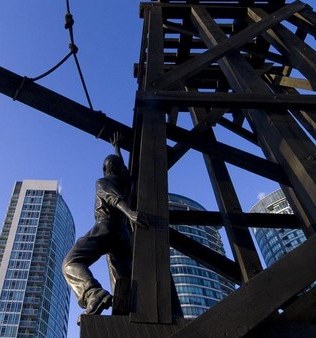  
L to
R: Monument to Chinese
railway workers in Toronto; Memorial quilt for young workers
killed on
the
job; Hamilton April
28 Day
of Mourning
monument.
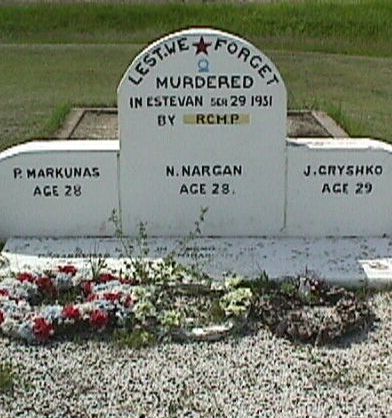 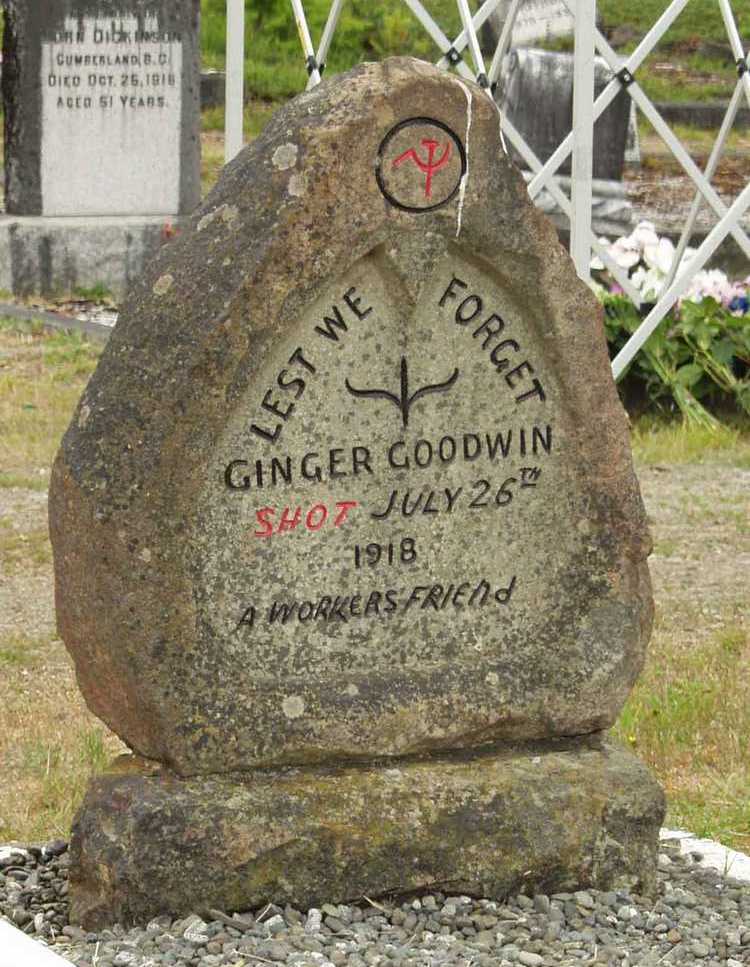 
L to
R: gravestones of coalminers in Estevan, Saskatchewan, and in
Cumberland, BC of mineworkers' organizer Ginger Goodwin, and monument
in
Ladysmith, BC to mineworker
Joseph Mair -- all were killed
defending workers' right to organize.
  
L to R: Net and Needle
fishermen's memorial in Steveston, BC; Lake
Cowichan, BC forestry
workers' memorial park; Vancouver memorial to nineteen
ironworkers killed in 1958
when a section of the Second Narrows bridge collapsed.

PREVIOUS
ISSUES | HOME
Website: www.cpcml.ca
Email: office@cpcml.ca
|

